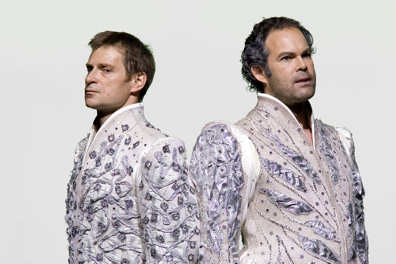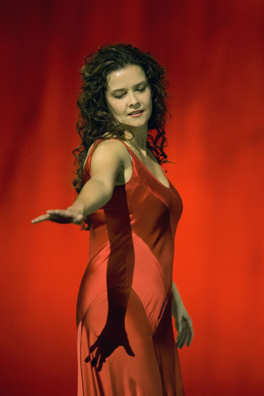|
|
|

Editorial
Board
London Editor:
(London UK)
Melanie
Eskenazi
Regional Editor:
(UK regions and Worldwide)
Bill
Kenny
Webmaster:
Bill
Kenny
Music Web Webmaster:
Len
Mullenger



|
MusicWeb is a
subscription-free site
Clicking Google adverts on our pages helps us keep it that way
Seen
and Heard Opera Review
Debussy,
Pelléas et Mélisande: Soloists;
Orchestra and Chorus of the Royal
Opera House, Sir Simon Rattle
(conductor) Royal Opera, London
11.05.2007 (AO)
Mélisande : Angelika Kirchschlager
Pélleas : Simon Keenlyside
Golaud: Gerald Finley
Geneviève: Catherine Wyn Rogers
Arkel: Robert Lloyd
Yniold: George Longworth
Director: Stanislas Nordev

There’s nothing
quite like Pelléas et Mélisande.
In many ways, it’s a huge symphony,
because so much of the action happens
in the music rather than on stage.
Yet it is more than a symphony because
it deals specifically with a story
bursting with symbolism, linking to
deeper and more complex ideas. The
textures and colours are intoxicating,
and the dream-like ambiguity
tantalises. Yet, it’s precisely
because there’s so much in this music
that interpretation is so essential.
Indeed, if there’s a single basic
criterion for judging merit, it’s how
well the interpretation elucidates the
work. All interpretations stem from
how the soul of the work is
understood, and how it’s realised in
performance. With like Pelléas et
Mélisande, the mystery is elusive,
so an unusual degree of sensitivity
can come into play.
As
sheer music, this was wonderful. The
music seemed like a living being, its
moods rapidly turning and changing.
At turns it was radiant, at other
moments darkly brooding. This matters
because the action in the libretto
unfolds slowly. The music progresses
the narrative. Because it’s
impressionistic, it hovers on the edge
of meaning as well as tonality. Simon
Rattle has performed a lot more
Debussy than recordings alone would
suggest. His approach here shows an
intuitive grasp of the composer’s
idiom, and of what makes it still
fresh and modern. This was playing of
great refinement, clearly and lucidly
detailed, yet passionately felt and
emotionally resonant. Indeed, it was
musicianship that made this
production.

The
narrative revolves around Mélisande,
so this production’s attempt to
explore her character was brave and
admirable. She’s usually depicted as
bland, child-like and wan, a blank
against whom the other characters
react. Yet, Golaud encounters her
deep in the forest. What’s a girl with
extremely long hair doing there? Why
is she so afraid that she’d rather
kill herself than reveal who she is?
Ancient folk myths make much of dense
forests as places of hidden menace, of
witchcraft and mystery. In our
post-Freudian times, we use the
terminology of the unconscious.
Somehow Mélisande connects with the
wild animal Golaud thinks he’s hunted
down. Is she another incarnation of
Die Hexe Lorelei? Shocking as
it may seem, this interpretation of
Mélisande’s character is therefore
perfectly valid. Indeed, the
culmination of the whole opera, in her
death scene, suddenly becomes more
pregnant (a Freudian slip on my part)
with significance. It also deftly
links the themes of sexuality,
succession and decay that run
throughout the narrative.
The
staging in this production starts off
very well indeed. The forest is
depicted by massive, impenetrable grey
blocks. Golaud’s castle, in contrast,
is unnaturally bright and luminous.
All the household – even Geneviève –
wear sparkling white uniforms. They
conform, they’re not wild creatures of
the forest. Superficially, this might
contradict the idea of the castle as a
place of gloom, but again there’s
justification in the text, which makes
much of the relentless heat, which is
also oppressive. It’s an important
foil to the music, with its depiction
of water, in the fountain, in the
watering of the garden, the sea, and
especially the abandoned fountain
whose waters once healed the blind.
At the stroke of noon, Golaud’s ring
falls into its depths, and Golaud
falls and is wounded.
The
images occur again and again in the
music, so there’s no missing them.
The superb playing saves the
production, as the staging doesn’t
develop meaningfully after the First
Act, or pick up on other levels in the
drama. For example, when Mélisande
leans over the pond, Pélleas is
terrified that she’ll fall in herself.
The music wells up (another Freudian
slip) alarmingly, creating a sense of
extreme tension and menace. Moreover,
it highlights the short phrase in
which Pelléas mentions that Golaud
first found Mélisande by a spring,
too. This confirms the idea that
Mélisande isn’t as innocent as she
seems. It could have been made quite
horrifying. Instead, Kirchschlager
just has to bend over the edge of the
stage, her short hair barely
disturbed. The sense of menace
evaporates. Similarly, the scene in
which Mélisande leans out of the
tower, letting her hair fall down,
also fits the idea of Mélisande as
temptress, for Freud has taught us
that hair, too, is often symbolic.
Admittedly, there are technical
difficulties in “showing” so much
hair, but it’s a lost opportunity.
It’s ironic then, that this
interpretation of Mélisande’s
personality, so well expressed in the
text and in the music, fails to impart
its full power in this rather spartan
production. It’s a brilliant, and
very well justified concept, which
makes it all the more unfortunate that
it couldn’t have been shown more
effectively in visual terms.
It is
in the final Act that the portrayal
works best, because it draws together
and makes logical sense of several
themes. Mélisande is dying,
ostensibly after childbirth. The red
backcloth matches the scarlet of her
dress. It is as if the whole scene
were a bloodbath, another telling
reference connecting hunting, to
Pelléas’s murder and to Golaud’s
injury. Instead of lying passively in
bed, Kirchschlager sits, upright and
tense in a chair in the front of the
stage. It’s a way of expressing the
fact that she’s chosen, once again,
“not” to speak or explain herself, and
seems to choose death, which she’s
mentioned several times in the past.
Indeed, even Golaud knows that she
really died long before, when he took
her from the forest and killed Pelléas.
That is why Debussy made such a point
of the infant’s silence. It doesn’t
even “cry” in the music. It’s
supposed to be impassive, like
Mélisande herself, who doesn’t explain
and doesn’t yield.
As Arkel sings, “il faut qu’il vive, à
sa place”.
What
will be her relationship with Yniold,
one wonders, particularly as Golaud
himself thinks Pelléas and Mélisande
kissed “like brother and sister”. The
story does not end.
The
singing, needless to say with this
cast, was excellent. Keenlyside is a
natural stage animal, much better in
roles where he can "become" character
than in Lieder. That's why he was so
effective in the Trisha
Brown realisation of Winterreise.
Because he's sung Pelléas so often,
he expressed a lot more about the role
than this production on its own terms
would suggest. For example, he managed
to convey the strange mix of naivety
and sexual awakening, so important in
the narrative. His voice is richer
now in its lower register. Soon,
he’ll be a Golaud not a Pelléas.
Angelika Kirchschlager's Mélisande of
course had much more colour and depth
than the usual “white” vocal style the
role usually gets, which I rather
liked, because it fitted well with the
music around the character. Finley's
Golaud, too, was nicely rounded,
making the role far more interesting
than if he were portrayed as a simple
brutish oaf. Again, his
characterisation fits in well with his
volte-face in the last Act,
where he suddenly shows self-knowledge
and begs Mélisande’s forgiveness.
Maybe the waters of the spring
symbolically cured his “blindness”,
even if they didn’t work for Arkel.
Keenlyside, Finley and Robert Lloyd,
as Arkel, also make a well-balanced
ensemble, and their voices work well
with Kirchschlager’s and Wyn Rogers’.
Good casting isn’t pick and mix,
because it’s meant to co-ordinate
artistically.
Friends of mine heard this same cast
with Rattle and the Berlin
Philharmonic in Germany recently,
(though Finley was indisposed and
temporarily replaced). Good as the
Royal Opera House orchestra is, it
can’t really outshine the Berliners at
their best. It was, however, a
semi-staged production, whereas the
original, at Salzburg, was the full
staged production we have in London.
In a sense, they might have got a
better deal experiencing it without
the staging, because they relied on
their imaginations and long-standing
familiarity with the opera. On the
other hand, though, even without sets
and costumes, it was created around
the same unusual and surprisingly
valid revaluation of the roles and
their relationship. Close your eyes,
then, and listen: it comes through as
music.
Anne
Ozorio
Pictures
©
Royal Opera 2007
Back
to the Top
Back to the Index Page
|
Seen and Heard, one of the longest established live
music review web sites on the Internet, publishes original reviews
of recitals, concerts and opera performances from the UK and internationally.
We update often, and sometimes daily, to bring you fast reviews,
each of which offers a breadth of knowledge and attention to performance
detail that is sometimes difficult for readers to find elsewhere.
Seen and Heard
publishes interviews with musicians, musicologists and directors
which feature both established artists and lesser known performers.
We also feature articles on the classical music industry and we
use other arts media to connect between music and culture in its
widest terms.
Seen and Heard
aims to present the best in new criticism from writers with a radical
viewpoint and welcomes contributions from all nations. If you would
like to find out more email Regional
Editor Bill Kenny. |
|
| |
|
Contributors: Marc
Bridle, Martin Anderson, Patrick Burnson, Frank Cadenhead, Colin
Clarke, Paul Conway, Geoff Diggines, Sarah Dunlop, Evan Dickerson
Melanie Eskenazi (London Editor) Robert J Farr, Abigail Frymann,
Göran Forsling, Simon Hewitt-Jones, Bruce Hodges,Tim Hodgkinson,
Martin Hoyle, Bernard Jacobson, Tristan Jakob-Hoff, Ben Killeen,
Bill Kenny (Regional Editor), Ian Lace, John Leeman, Sue Loder,Jean
Martin, Neil McGowan, Bettina Mara, Robin Mitchell-Boyask, Simon
Morgan, Aline Nassif, Anne Ozorio, Ian Pace, John Phillips,
Jim Pritchard, John Quinn, Peter Quantrill, Alex Russell, Paul
Serotsky, Harvey Steiman, Christopher Thomas, Raymond Walker, John Warnaby,
Hans-Theodor Wolhfahrt, Peter Grahame Woolf (Founder & Emeritus
Editor)
|
Site design: Bill Kenny
2004 |

